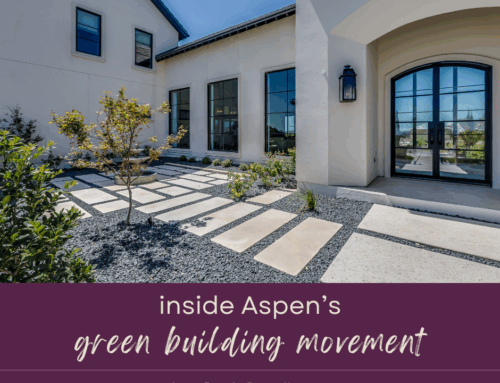
Homes consume a lot of energy – and sometimes they’re just not that good for the environment. But there’s good news: You can make your home more eco-friendly and save yourself some cash in the process.
Here’s what you need to know.
10 Tips to Make Your Home More Eco-Friendly
Making your home eco-friendly is definitely a worthy goal. You’ll make a smaller impact on the planet and maybe even give a little back to the environment – and you’ll save money on utility costs, too. Check out these ten tips to make your home more eco-friendly:
- Buy low- or no-VOC materials, and dispose of old household supplies properly.
- Take off your shoes.
- Switch to LEDs or CFL lights.
- Create a compost station.
- Seal gaps where air can get in or out.
- Fix all your leaks.
- Collect rainwater.
- Fix your insulation.
- Choose low-flow showerheads and toilets.
- Install solar panels.
Here’s a closer look at each tip.
#1. Buy low- or no-VOC materials, and dispose of old household supplies properly.
Who doesn’t like the smell of fresh paint? The problem is that the smell of fresh paint (and the smell of a new car, for that matter) comes from off-gassing, which is the evaporation of chemicals. A lot of household items, including paint, cleaning supplies, and new furniture, contain volatile organic compounds. Indoor pollutants are dangerous, and they can even be up to a hundred times higher than outdoor pollution levels. Choose low- or no-VOC materials to keep your indoor air fresher, and invest in plants to release clean oxygen inside your home.
Related: 4 great indoor houseplants for your Aspen home
#2. Take off your shoes.
Tracking in toxins and pollutants on your shoes? Take them off at the door. You don’t want unhealthy pathogens, chemicals and other pollutants coming into your home.
#3. Switch to LEDs or CFL lights.
More than 10 percent of the average home’s energy bill goes toward lighting, which means you could probably save some cash by switching to LED or CFL lighting. Besides, these types of lights help the environment because they use less energy than standard incandescent bulbs do.
#4. Create a compost station.
Recycling and composting is a lot easier when you set yourself up for success. You can place recycling bins in each room of your home (including the bathrooms and home office) to simplify the process. And even better, start composting; about half the trash that comes out of American homes is actually food scraps. You can use your own compost to make fertilizer for your garden (which improves curb appeal).
Related: Should you upgrade your landscaping before you sell your home?
#5. Seal gaps where air can get in or out.
Leaky windows and doors can wreak havoc on your energy costs, so take the time to ferret them out and repair them. Putting weather stripping in all the right spots can even save you up to 10 percent on your heating and cooling bill while helping consume less energy.
#6. Fix all your water leaks.
Even a dripping faucet costs you money over time, so it’s always a good idea to make sure your plumbing is up to snuff. As many as 10 percent of homes have water leaks that waste 90 gallons (or more) every day, according to the Environmental Protection Agency.
#7. Collect rainwater.
You can use collected rainwater to water your garden (it pairs well with compost) or even your yard – and you may even have a surplus. Just one day of heavy rain can dump up to 300 gallons of water on your roof, and most of it typically flows into the street. From there, it goes into the city’s stormwater collection system, and you lose out. You’ll want to hire a pro to clip your gutters so they can redirect water into a rain barrel.
#8. Fix your insulation.
Most roofs are dark-colored, which means they absorb heat from the sun. That means your attic heats up – and if it’s properly insulated, it’ll act as a buffer for the air in your house. Good insulation will prevent conditioned air from escaping, and that means your heater and air conditioning unit don’t have to work as hard.
#9. Choose low-flow showerheads and toilets.
Older showerheads can release up to 5 gallons of water in just one minute, and that adds up quickly. A five-minute shower can cost you 25 gallons (and if you live in a house with others, expect that to rise exponentially). It’s almost always better to invest in a low-flow shower head, which can provide you with the same amount of water pressure while using a fraction of the water. (That helps on your heated water costs, too.)
Toilets are the main source of water use in American homes. In fact, they take up nearly 30 percent of a house’s water consumption, on average. One flush can suck away up to 6 gallons, so low-flow is definitely the way to go.
#10. Install solar panels.
Solar panels may be the single-best investment you make in your home. The cost pays off, too; energy savings add up quickly. You can either buy them or lease them month to month. The best part about leasing? The company that owns them will maintain them.
Are You Selling or Buying a Home in Aspen?
If you’re ready to sell your home in Aspen, Woody Creek, Basalt, Carbondale or Snowmass, we may be able to help you.
Get in touch with us right now to find out how much your home is worth – and discover how we’ll be able to help you sell it quickly and for top dollar.
If you’re also looking for a home for sale in Aspen or a nearby community, check out our listings by price:
- $200k to $300k
- $300k to $400k
- $400k to $500k
- $500k to $600k
- $600k to $700k
- $700k to $800k
- $800k to $900k
- $900k to $1 million
- Over $1 million
Error 401: Access key is invalid or has been revoked, please ensure there are no spaces in your key.
If the problem persists, please reset your API key in the IDX Broker Dashboard, or contact help@idxbroker.com














